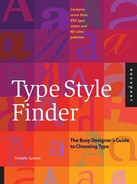
A Type and Color Primer
6
Alphabet Structure and Variation
The twenty-six letters in the English alphabet are interrelated.
Drawn with a minimum of strokes, each archetypal form is as
different as possible from all the others. Some forms—E, F, H, I,
J, L, and T, for example—are related visually and historically,
but while they are similar in that they are composed only of
horizontal and vertical strokes, they also are different enough
to be easily distinguished.
The letterforms in all typefaces vary from their archetypes in
only six aspects: case, weight, contrast, width, posture, and
style. Type designers—referring to historical models—subtly
alter and combine the variables in these six aspects to create
individual type styles that, though appearing remarkably differ-
ent, all convey the same information about the letterforms in
the alphabet. Different approaches to the drawing of typefaces
have evolved, become popular, or been discarded over time,
and as a result, the formal aspects of particular typefaces often
carry associations with specific periods in history, cultural
movements, or geographic location—some faces feel “modern”
or “classical,” others feel “French” or “English.” More important,
the drawing of a typeface often exhibits a particular kind of
rhythm, or cadence, and provides distinct physical presence
in a design that may connote feelings—fast or slow, aggressive
or elegant, cheap or reliable. It’s important to consider that not
all viewers will perceive the same associations in a given type-
face; the designer must therefore carefully evaluate his or her
typeface selection in the context of the audience for a particular
piece. Additionally, mixing typefaces that are incongruous—
for example, using an archaic Roman capital in a flyer promot-
ing an electronica concert—will often add surprising layers of
communication to the overall message.
Further, the drawing characteristics of typefaces affect their
functional qualities, making some more legible at certain sizes
or affected by color in particular ways. Recognizing and under-
standing the six fundamental aspects of alphabet variation is
an important first step in being able to select and combine
appropriate typefaces for a job.
The most subtle alteration of even one variable of a
letter’s archetypal structure—and more so in combi-
nation—results in typefaces of dramatically different
appearance. The essential characteristics of the base
structure, so long as they remain intact, allow these
variations in form to be perceived and understood
without difficulty. In the example below, an overlay of
various uppercase A’s reveals the infinite possibilities
within the archetype: two diagonals, meeting at an
apex, joined by a horizontal stroke.
Letterform Anatomy
The strokes of letters share a terminology codified
among scribes and typesetters for 2,000 years.
These terms are among those in standard usage
among type designers.
Capline
x-Height Ear
E
ye Spur Descender
Apertures
Leg Serif Bowl
Apex Stem Crossbar Terminal
Loop
Ascender
Shoulder
TittleT
erminal
Baseline Counter
(Provision) Type Style Finder
CD606.006 / 4108
1 TSF_FM_001-015_new.qxd 6/3/06 10:25 AM Page 6

Type Style Finder
7
Case Every letter in the Western alphabet occurs in a
large form—the capitals, or uppercase—and a small,
more casual form—lowercase. The uppercase requires
added space between letters to permit easier reading.
The lowercase is more varied and more quickly recog-
nized in text.
Weight The overall thickness of the strokes, relative
to the height of the uppercase, may change. Light,
regular, bold, and black weights—increasing in stroke
thickness—for a single type style define a type family.
Variation in weight helps add visual contrast, as
well as helps distinguish between informational
components within a hierarchy.
Contrast The strokes within the letters of a typeface
may be uniform in weight or may vary significantly; the
more they do so, the more contrast the face is said to
exhibit. Contrast within a stroke—such asflaring from
thin to thick—is called modulation; the rate at which
this occurs is referred to as the typeface’s ductus.
Width The proportional width of the letters in a
typeface is based on the width of the uppercase M.
Faces that are narrower are said to be condensed,
while wider ones are said to be extended or expanded.
Posture Roman letters are those whose vertical axis
is 90° to the baseline—they stand upright. Italic
letters, developed by humanist scholars during the
Renaissance, slant 12–15° to the right, mimicking
the slant of handwriting.
Style This term is used to describe 1) the two major
classes of type—serif (having little feet at the ends
of the strokes) and sans serif (having no such feet);
2) the historical period in which the typeface was
drawn; and 3) the relative neutrality or decorative
quality of a typeface. Typefaces that are neutral are
closest to the basic structure, while those with
exaggerated characteristics are said to be stylized,
idiosyncratic, or decorative.
Three letters shown in uppercase (left) and lowercase (right)
Three uppercase letters in roman and corresponding italic
Style in a historical progression, archaic to contemporary Style in terms of decorative quality
Serif
Archaic
Serif
Transitional
Sans Serif
Modern
Neutral Stylized
Light Medium Bold Black
Unif
orm Strokes Slight Contrast
and Modulation
High Contrast Extreme Contrast
Extra Condensed Condensed Regular Extended or
Expanded
(Provision) Type Style Finder
CD606.006 / 4108
1 TSF_FM_001-015_new.qxd 6/3/06 10:25 AM Page 7
..................Content has been hidden....................
You can't read the all page of ebook, please click here login for view all page.
